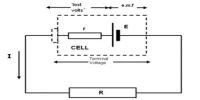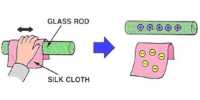Microphone and Speaker Microphone is orally known as the mic. In a big meeting or program, a speaker delivers his speech in front of an electronic device which is known as a microphone or mic. Microphone converts sound into an electric signal. The audience can hear it loudly through a loudspeaker. Because the speaker transforms the electric signal of the microphone into sound. Perhaps you will have seen the use of a microphone and speaker in various ceremonies of your school. Both microphones and speakers are found in tape-recorder, VCR, etc.

Functions: We have already said that a microphone is such a device that changes sound wave into electrical audio wave or signal. The frequency and relative amplitude of the electrical audio signal remains the same as that of the sound wave. There are a moving coil and a thin metallic sheet named diaphragm in the microphone. When a person speaks through a microphone, the diaphragm vibrates by the sound wave.
A microphone is a tool that captures audio by converting sound waves into an electrical signal. When you speak, sound waves created by your voice carry energy toward the microphone. This signal can be augmented as an analog signal or might be converted to a digital signal, which can be processed by a computer or other digital audio device. Remember that sound we can listen to is energy carried by vibrations in the air.
Microphones are transducers, which alter one form of energy into another. They are susceptible to changes in force in the adjoining air, and they adapt those changes into changes in voltage of an electrical current, which travels down the mic cable to whatever mechanism the mic is linked to. Thereby, when using a microphone, one is capable to record electronically what happened acoustically in front of the mic’s capsule.
The diaphragm is that part of the microphone which is designed to transform the vibration of sound into electricity. The vibration of different types of sounds vibrates the diaphragm. differently. This vibration makes the diaphragm move to and fro in the magnetic field. As a result, an alternating electric current is induced in the moving coil. Thus microphone converts the sound energy into electrical energy. This is called an audio signal. Having amplified, this electric audio signal can be transferred to a long distance through a telephone line or radio So microphone plays a vital role in television and radio broadcasting, recording and telephone.
Microphones accomplish the contradictory act of speakers, which convert electrical signals into sound waves.
Different Parts of a Microphone:
- Wind Screen: This is the element of the mic you speak into. Usually, a microphone has a round defensive obstacle made of woven hard metal.
- Diaphragm: This is the casing of the microphone that is mainly comparable to our eardrums. As sound waves enter the microphone, they congregate the diaphragm and cause the diaphragm to vibrate.
- Coil: The coil is exceptional to dynamic microphones. The coil is attached to the diaphragm so when the diaphragm begins to vibrate, so will the coils.
- Magnetic Core: This is also distinctive to a dynamic microphone. The magnetic core creates a magnetic field for the coil so that the vibrations can generate an electric signal.
- Capsule: On any microphone, the capsule is where the sound is transformed from vibration to electric signal. Some microphones necessitate power for the capsule to do its job at the same time as others do not.
- Body: The body of the microphone almost certainly has the least to do with its eminence of sound and the most to do with how long your microphone will last.
- Output: On any microphone, this is where you would plug a cable into the mic.













